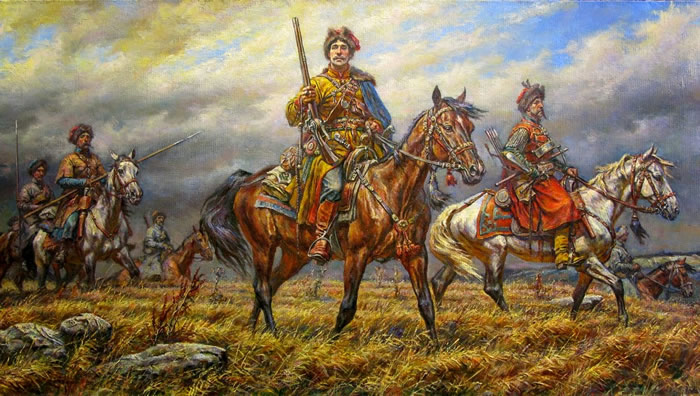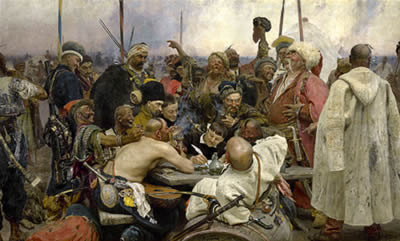 |
| Cossacks |
The Cossacks originally settled in the southern steppes of Europe and into Russia. As early as 1380, the Cossacks along the Don River are recorded as fighting with the Russian grand duke Dmitri against the Mongols. On September 8, 1380, Dmitri won a decisive victory over the Mongols at Kulikovo by the Don River, effectively marking the end of Mongol rule over much of Russia.
By the 16th century, the Cossacks had merged into two large autonomous bands, the Don Cossacks and the Zaporojie, who lived along the bends of the river Dnieper. (Zaporojie is translated as “below the bend in the river.”) Other historians have pointed to additional areas of Cossack settlement as time progressed, including areas in which entire settlements of Cossacks resided.
While surrounded by the power of the growing Russian state of Poland in addition to the Crimean Tartars (or Mongols), the Cossacks still managed to keep a large measure of independence because of their military prowess.
  |
Many serfs, or slaves, ran off to join the Cossacks because the measure of freedom enjoyed under the Cossack leaders (called atamans or hetmans) was not found anywhere else in Russia or East Europe during that period. The word Cossack is derived from the Turkic term kazak, meaning “free man.”
Most of the Cossacks were of Slavic descent, and the majority Christian, usually of the Russian Orthodox faith. The Cossacks were governed by the Rada, or Legislative Assembly, led by the ataman. During wartime, the ataman served as the supreme war commander.
The Cossacks realized that keeping their freedom meant keeping their military skills at a high degree of readiness. Their lifestyle reflected the influence of the Mongols before them. Boys were given weapons almost as soon as they could hold them and taught to ride sometimes before they could even walk.
Indeed, the main strength of the Cossacks came from the quick charges they could execute on their horses. The atamans staged sham battles with the younger boys to accustom them to a military life from as early an age as possible. Brave and daring boys were noticed by the leader and were marked from an early age for advancement.
Cossacks began to use their centralized position to raid the domains of the nations growing around them, although most of their attacks were directed toward the Muslim Tartars of the Crimea and the Turks of the Ottoman Empire. At the same time, when the frontiers of the powers in East Europe were so fluid, each county could see the value of the Cossacks as frontier troops, perfectly suited to counter raiders from enemy lands.
In 1569, Poland and Lithuania formally became the Union of Lublin. Lithuanian grand duke Jogaila ruled the united monarchy as Ladislas (Władysław) II Jagiello, first of the Jagiello dynasty. The pact that set the state for his marriage to the queen of Poland stipulated that he become a Roman Catholic, the religion of Poland.
In 1596, the Union of Brest united the Russian Orthodoxy of Lithuania with the Roman Catholicism of Poland to form what was known as the Uniate Church. The Uniate Church began a persecution of Orthodox believers who would not convert, and perhaps thousands fled to the Sech Commonwealth of the Cossacks.
In 1645, Ladislas IV sought to involve the Cossacks, who by now were within the boundaries of Polish power, in war against the Ottoman Empire. When his plans were revealed, the Cossacks feared becoming the scapegoats for the two countries.
   |
In addition to the continued persecution of the Orthodox Church, the exposure of Ladislas’s secret treaty led the Cossacks under Bohdan Khmelnitsky to rise up against Poland in 1648, the very year that the Treaty of Westphalia sought to bring peace to Europe by ending the Thirty Years’ War (1618–48).
Khemelnitski formed an alliance with the Tartars and the Zaporojie Cossacks and led an invasion of Poland. Polish serfs rose up when Khmelnitski approached. For six years, the rebellion ravaged Poland and the Ukraine. Thousands of Poles and Jews were massacred in some of the most savage butchery ever seen in Europe.
Finally in 1654, seeing that the destruction of the Polish Kingdom was beyond his means, Khmelnitski took the irrevocable step of making an alliance with Czar Alexei, the second of the Romanov dynasty. Tragically for the Cossacks’ love of freedom, Khmelnitski had exchanged one master for another, the Polish king for a Russian czar.
Under the Romanovs, the 17th century saw a tightening of the control of Russia over the Cossacks. The Russians saw the Cossacks as excellent troops to be used against the Ottoman Turkish Empire.
The Cossacks carried out fierce raids against the Tartars and in 1663, Turkish sultan Mohammed IV sent a large army against the Zaporojie Cossacks. Although the Zaporozhians were asleep after a drinking bout, one aroused himself in time to see the Turks approaching. Incredibly, the Cossacks were able to fend off their attackers and force them to retreat.
Eventually, the tension between Russian rule and the Cossacks’ desire for freedom led to the rebellion of Stephan (Stenka) Razin in the last years of Czar Alexei’s reign. Razin turned against the Russians in 1670, beginning what became a full-fledged Cossack revolt.
Although many Cossacks joined him, others allied themselves with the Russians, whose disciplined troops soon crushed Razin’s uprising at Simbirsk. After undergoing torture in Moscow, Razin was beheaded in 1671. Ever after, he became a symbol of Russian resistance to tyranny.
The son of Czar Alexei, Peter I, or Peter the Great, recognized the military potential of the Cossacks, despite their rebelliousness. In 1696, Peter seized the Black Sea port of Azov from the Turks, thanks to his Cossack allies.
The greatest test of Peter’s reign came in the Great Northern War against King Charles XII of Sweden (1700–21). Ivan Mazeppa was the leading Cossack hetman at the time, and he reestablished the Cossacks as an important factor in eastern European affairs, balancing the ambitions of Poland and Russia.
 |
| rebelliousness |
When Peter decisively defeated Charles at Poltava in July, Mazeppa was forced to flee. Mazeppa died of natural causes in September 1709, before Peter could catch him. After Mazeppa, the Cossacks became a part of the Russian Army, even raiding Berlin in the army of Czarina Elizabeth during the Seven Years’ War (1756–63) against Frederick II of Prussia.
However, the Cossacks’ love of liberty would lead to one more rebellion before the close of the 18th century. When Elizabeth died in 1762, her son Peter III was overthrown and killed in a palace coup by his wife, Catherine. Catherine, who would be known to history as Catherine the Great, was faced in September 1773 with the rebellion of the Don Cossack Emelian Pugachev.
To the serfs of Russia, little better than slaves, Pugachev seemed to be their champion, as he fought against the oppressing landlords. In March of 1774, Pugachev was defeated by Catherine’s troops at Orenburg; as was Razin, he was executed by beheading.
The rebellion of Pugachev was the last real defiance against the loss of the Cossacks’ liberty. It is one of the great ironies of history that in later years, the Cossacks would become some of the most ruthless defenders of the Russian despotism against which they once had fought so bravely.
